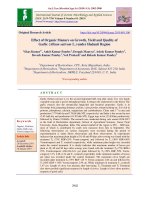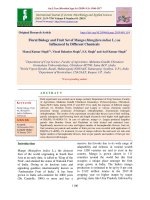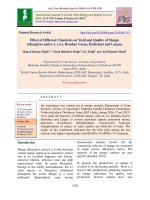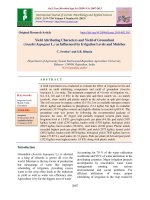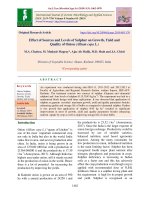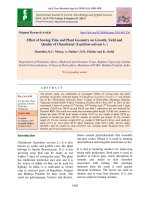Yield and quality of sesame (Sesamum indicum L.) as influenced by nitrogen and potassium application
Bạn đang xem bản rút gọn của tài liệu. Xem và tải ngay bản đầy đủ của tài liệu tại đây (243.86 KB, 7 trang )
��������������������������������������������������������������������������������������������������������������������������������������������������������������������������������������������������������������������������������������������������������������������������������������������������������������������������������������������������������������������������������������������������������������������������������������������������������������������������������������������������������������������������������������������������������������������������������������������������������������������������������������������������������������������������������������������������������������������������������������������������������������������������������������������������������������������������������������������������������������������������������������������������������������������������������������������������������������������������������������������������������������������������������������������������������������������������������������������������������������������������������������������������������������������������������������������������������������������������������������������������������������������������������������������������������������������������������������������������������������������������������������������������������������������������������������������������������������������������������������������������������������������������������������������������������������������������������������������������������������������������������������������������������������������������������������������������������������������������������������������������������������������������������������������������������������������������������������������������������������������������������������������������������������������������������������������������������������������������������������������������������������������������������������������������������������������������������������������������������������������������������������������������������������������������������������������������������������������������������������������������������������������������������������������������������������������������������������������������������������������������������������������������������������������������������������������������������������������������������������������������������������������������������������������������������������������������������������������������������������������������������������������������������������������������������������������������������������������������������������������������������������������������������������������������������������������������������������������������������������������������������������������������������������������������������������������������������������������������������������������������������������������������������������������������������������������������������������������������������������������������������������������������������������������������������������������������������������������������������������������������������������������������������������������������������������������������������������������������������������������������������������������������������������������������������������������������������������������������������������������������������������������������������������������������������������������������������������������������������������������������������������������������������������������������������������������������������������������������������������������������������������������������������������������������������������������������������������������������������������������������������������������������������������������������������������������������������������������������������������������������������������������������������������������������������������������������������������������������������������������������������������������������������������������������������������������������������������������������������������������������������������������������������������������������������������������������������������������������������������������������������������������������������������������������������������������������������������������������������������������������������������������������������������������������������������������������������������������������������������������������������������������������������������������������������������������������������������������������������������������������������������������������������������������������������������������������������������������������������������������������������������������������������������������������������������������������������������������������������������������������������������������������������������������������������������������������������������������������������������������������������������������������������������������������������������������������������������������������������������������������������������������������������������������������������������������������������������������������������������������������������������������������������������������������������������������������������������������������������������������������������������������������������������������������������������������������������������������������������������������������������������������������������������������������������������������������������������������������������������������������������������������������������������������������������������������������������������������������������������������������������������������������������������������������������������������������������������������������������������������������������������������������������������������������������������������������������������������������������������������������������������������������������������������������������������������������������������������������������������������������������������������������������������������������������������������������������������������������������������������������������������������������������������������������������������������������������������������������������������������������������������������������������������������������������������������������������������������������������������������������������������������������������������������������������������������������������������������������������������������������������������������������������������������������������������������������������������������������������������������������������������������������������������������������������������������������������������������������������������������������������������������������������������������������������������������������������������������������������������������������������������������������������������������������������������������������������������������������������������������������������������������������������������������������������������������������������������������������������������������������������������������������������������������������������������������������������������������������������������������������������������������������������������������������������������������������������������������������������������������������������������������������������������������������������������������������������������������������������������������������������������������������������������������������������������������������������������������������������������������������������������������������������������������������������������������������������������������������������������������������������������������������������������������������������������������������������������������������������������������������������������������������������������������������������������������������������������������������������������������������������������������������������������������������������������������������������������������������������������������������������������������������������������������������������������������������������������������������������������������������������������������������������he crop in the soil. The
biological yield is a function of seed and stalk
yields. Thus, significant increase in biological
yield with the application of N could be
ascribed due to increased seed and stalk yield,
hence, harvest index remained unchanged due
to varying levels of N. The results of present
investigation are in line with those of Tripathi
and Rajput (2007), Sarala and Jagannatham
(2002) in sesame.
Yield
It is apparent from data presented in table 2
(Fig 3) that seed yield of sesame increased
significantly with successive increase in level
of potassium upto 20 kg/ha.
This level of potassium fertilization produced
the seed yield of 958 kg/ha, thereby,
registering a quantum increase of 81 and 247
kg/ha over 10 kg/ha and control, respectively.
Stalk and biological yield also increase
significantly with the above same level of
potassium. These results are in close
conformity with the findings with those of
Sarkar and Pal (2005), Jadav et al., (2010) on
sesame.
Quality
Results revealed that increasing levels of N
significantly increase in oil percentage and oil
yield with suitable dose of N i.e. 40 kg/ha was
observed in the present investigation because
of increased N content in seed which might be
the result of increased availability of nitrogen
to plants. These results are in close
conformity with the findings of Mondal et al.,
(2001), Patra (2001), Tripathy and Bastia
(2012) in sesame.
Quality
Results revealed that increasing levels of
potassium significantly increases oil content
and oil yield in sesame. Data in table 2
indicated that the application of potassium at
20 and 30 kg/ha significantly improved the oil
127
Int.J.Curr.Microbiol.App.Sci (2019) 8(6): 125-131
content over control. The results are in
agreement with those of Mollashahi et al.,
(2013), Viradiya et al., (2004) and Mondal et
al., (1997).
Table.1 Effect of nitrogen and potassium on yield attributes and test weight
Treatments
Yield attributes
No of capsules/ plant
No of seeds/ capsule
Nitrogen (kg/ha)
0
20
40
60
SEm±
CD (P=0.05)
Potassium (K2O kg/ha)
0
20
30
40
SEm±
CD (P=0.05)
Test weight (g)
33.40
39.67
42.63
43.66
0.92
2.64
30.96
36.95
40.20
41.28
0.92
2.66
2.48
2.59
2.67
2.70
0.05
0.15
35.75
38.84
41.71
43.06
0.92
2.64
33.68
36.45
39.17
40.09
0.92
2.66
2.49
2.59
2.66
2.70
0.05
0.15
N= Nitrogen, K2O= Potassium, HI= Harvest index
Table.2 Effect of nitrogen and potassium on yield, harvest index, oil content and oil yield of
sesame
Treatments
Seed yield
Nitrogen (kg/ha)
642
0
881
20
983
40
1020
60
24
SEm±
69
CD (P=0.05)
Potassium (K2O kg/ha)
711
0
877
20
958
30
980
40
24
SEm±
69
CD (P=0.05)
Yield (kg/ha)
Stalk
Biological
yield
yield
Oil
Oil
Content
Oil Yield
(kg/ha)
Harvest
Index
(%)
1812
2470
2821
2893
65
186
2454
3351
3735
3896
78
224
43.29
46.11
48.86
49.48
0.95
2.72
279.84
406.78
482.68
506.94
14.49
41.71
26.15
26.30
26.38
26.12
0.41
NS
2009
2477
2727
2783
65
186
2753
3330
3630
3722
78
22
44.67
46.41
47.72
48.94
0.95
2.72
321.64
407.18
463.67
483.75
14.49
41.71
25.89
26.30
26.45
26.32
25.89
NS
128
Int.J.Curr.Microbiol.App.Sci (2019) 8(6): 125-131
Abbreviations
@
%
DAP
d.f
DAS
et al.,
G
Viz.,
0
C
NS
At the rate of
Per cent
Di ammonium phosphate
Degree of freedom
Days after sowing
(et alibi) and else where
Gramme
Namely
Degree Celsius
Non-significant
Ha
i.e.
kg/ha
No.
Cm
Ha
LAI
M
M2
SEm+
Hectare
That is
Kilogram per hectare
Number
Centimeter
Hectare
Leaf area index
Metre
Square
Standard error of mean
Fig.1 Effect of nitrogen and potassium on yield attributes of sesame
Fig.2 Effect of nitrogen and potassium on test weight
129
Int.J.Curr.Microbiol.App.Sci (2019) 8(6): 125-131
Fig.3 Effect of nitrogen and potassium on seed, stalk and biological yield
5: 144-147.
Mollashahi, M., Ganjali, H. and Fanaei H.
2013. Effect of different levels of
nitrogen and potassium on yield, yield
components and oil content of
sunflower. International Journal of
Farming and Allied Sciences, 2: 12371240.
Mondal, S.S., Pramanik, C.K. and Das, J.
2001. Effect of nitrogen and
potassium on oil yield, nutrient uptake
and soil fertility in soybean (Glycine
max) - sesame (Sesamum indicum)
intercropping system. Indian Journal
of Agricultural Sciences 71(1): 44-46.
Mondal,
S.S.,
Dasmahapatra,
A.N.,
Chatterjee, B.N. and Maiti, P.K. 1997.
Effect of potassium application on the
yield and oil content of sesame,
mustard and groundnut on a Kdeficient soil. Journal of Potassium
Research13 : 153-158.
Patra, A.K. 2001. Yield and quality of sesame
(Sesamum indicum L.) as influenced
by N and P during post-rainy season.
Annals of Agricultural Research
22(2): 249-252.
Sarala, N.V. and Jagannatham, A. 2002.Effect
of nitrogen and Azospirillum on yield
Application of research/Future perspective
Based on the one year of study it is
recommended that 40 kg/ha N and Potassium
at 30 kg K2O should be applied for better
nutrient management in kharif season
respectively, for obtaining higher growth in
Sesame.
Acknowledgement / Funding
Author thankful to SKN College of
Agriculture, Sri Karan Narendra Agricultural
University, Jobner, 303328, Rajasthan, India.
Research project name or number: MSc
Thesis
References
Chhonkar, P.K., and Rattan, R.K. 2000. Soil
and fertilizer management for
sustainable
agriculture.
Indian
Farming, 2:28.
Jadav, D.P., Padamani, D.R., Polara, K.B.,
Parmar, K.B. and Babaria, N.B. 2010.
Interaction effect of sulphur and
potassium on yield and nutrients
uptake by sesame (Sesamum indicum
L.). An Asian Journal of Soil Science
130
Int.J.Curr.Microbiol.App.Sci (2019) 8(6): 125-131
attributes and yield of sesame under
rainfed conditions. Journal of Oilseeds
Research 19 (1): 125-126.
Sarkar, R.K and Pal P.K. 2005. Effect of crop
geometry, fertility level and nipping
on physiological
parameters in
relation to productivity of sesame
(Sesamum indicum L.). Indian Journal
of Agricultural Science 75(3): 143147.
Tripathi, M.L. and Rajput, R.L. 2007.
Response of sesame (Sesamum
indicum) genotypes to levels of
fertilizers. Advances in Plant Sciences,
20(2): 521-522.
Tripathy, S and Bastia, D.K. 2012. Irrigation
and nutrient management for yield
augmentation of summer sesame
(Sesamum indicum L.).Journal of
Crop and Weed8 (2):53-57.
Viradiya, M.B., Marsonia, P.J. and Golakiya,
B.A. 2004. Response of summer
groundnut (Arachis hypogaea L.) to
potassium in the diverse soils of
Saurashtra. Advances Plant Sciences
17: 615-618.
How to cite this article:
Anju Bijarnia, O.P. Sharma, Babu Lal, Arjun lal Bijarnia and Ramesh Choudhary. 2019. Yield
and Quality of Sesame (Sesamum indicum L.) as Influenced by Nitrogen and Potassium
Application. Int.J.Curr.Microbiol.App.Sci. 8(06): 125-131.
doi: />
131
![Growth and yield of Ashwagandha [Withania somnifera (L.)] as influenced by different intercropping system in Kymore plateau of Madhya Pradesh](https://media.store123doc.com/images/document/2020_01/09/medium_vsb1578562778.jpg)

